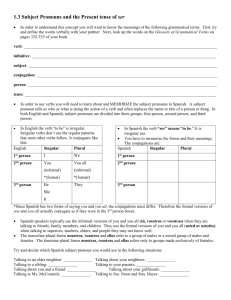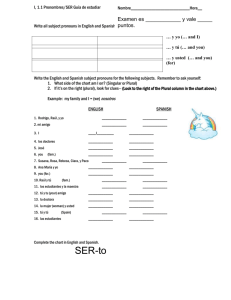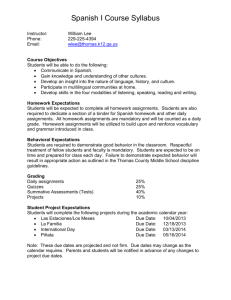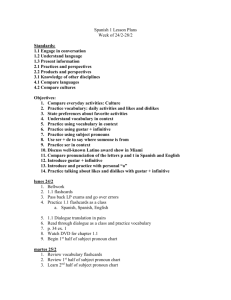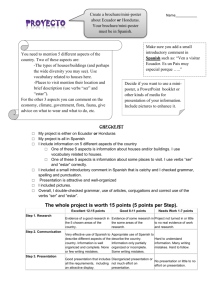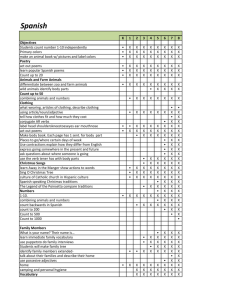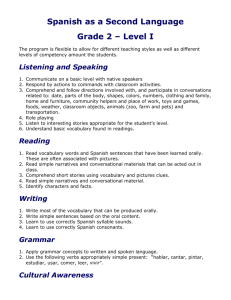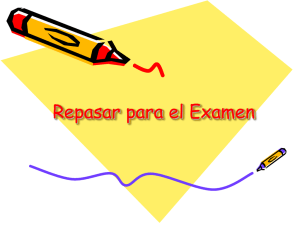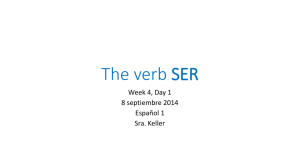Spanish%201%20Midterm%20Review%20A%20Concept
advertisement
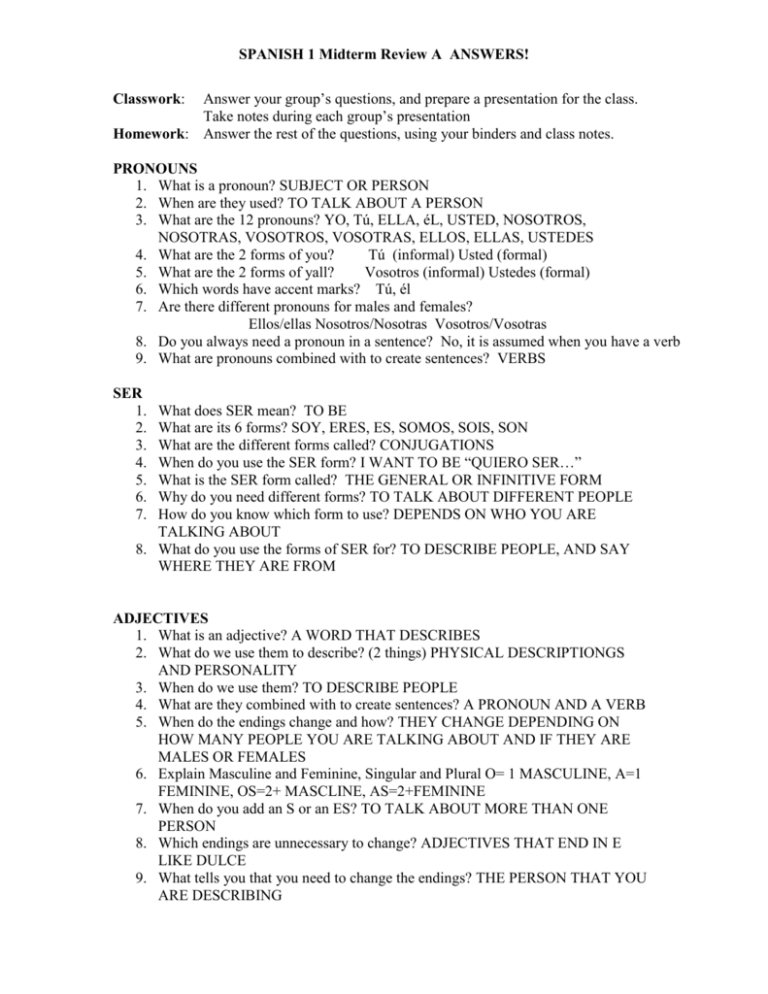
SPANISH 1 Midterm Review A ANSWERS! Answer your group’s questions, and prepare a presentation for the class. Take notes during each group’s presentation Homework: Answer the rest of the questions, using your binders and class notes. Classwork: PRONOUNS 1. What is a pronoun? SUBJECT OR PERSON 2. When are they used? TO TALK ABOUT A PERSON 3. What are the 12 pronouns? YO, Tú, ELLA, éL, USTED, NOSOTROS, NOSOTRAS, VOSOTROS, VOSOTRAS, ELLOS, ELLAS, USTEDES 4. What are the 2 forms of you? Tú (informal) Usted (formal) 5. What are the 2 forms of yall? Vosotros (informal) Ustedes (formal) 6. Which words have accent marks? Tú, él 7. Are there different pronouns for males and females? Ellos/ellas Nosotros/Nosotras Vosotros/Vosotras 8. Do you always need a pronoun in a sentence? No, it is assumed when you have a verb 9. What are pronouns combined with to create sentences? VERBS SER 1. 2. 3. 4. 5. 6. 7. What does SER mean? TO BE What are its 6 forms? SOY, ERES, ES, SOMOS, SOIS, SON What are the different forms called? CONJUGATIONS When do you use the SER form? I WANT TO BE “QUIERO SER…” What is the SER form called? THE GENERAL OR INFINITIVE FORM Why do you need different forms? TO TALK ABOUT DIFFERENT PEOPLE How do you know which form to use? DEPENDS ON WHO YOU ARE TALKING ABOUT 8. What do you use the forms of SER for? TO DESCRIBE PEOPLE, AND SAY WHERE THEY ARE FROM ADJECTIVES 1. What is an adjective? A WORD THAT DESCRIBES 2. What do we use them to describe? (2 things) PHYSICAL DESCRIPTIONGS AND PERSONALITY 3. When do we use them? TO DESCRIBE PEOPLE 4. What are they combined with to create sentences? A PRONOUN AND A VERB 5. When do the endings change and how? THEY CHANGE DEPENDING ON HOW MANY PEOPLE YOU ARE TALKING ABOUT AND IF THEY ARE MALES OR FEMALES 6. Explain Masculine and Feminine, Singular and Plural O= 1 MASCULINE, A=1 FEMININE, OS=2+ MASCLINE, AS=2+FEMININE 7. When do you add an S or an ES? TO TALK ABOUT MORE THAN ONE PERSON 8. Which endings are unnecessary to change? ADJECTIVES THAT END IN E LIKE DULCE 9. What tells you that you need to change the endings? THE PERSON THAT YOU ARE DESCRIBING SPANISH 1 Midterm Review A ANSWERS! VERBS and LIKES 1. What is a verb? AN ACTION WORD 2. What do verbs all look like in Spanish? THEY END IN R 3. What do you combine them with to create sentences? WITH A LIKE WORD, FOR EXAMPLE GUSTA 4. What are the 5 Likes (Like, Hate, Love, Kinda Like, Dislike) GUSTA, DA ASCO, ENCANTA, FASCINA, DISGUSTA 5. What are the little words you write in front of Gusta to make a sentence? ME=I, TE=YOU, LE=HE/SHE, NOS=WE, LES=THEY 6. How do you know which little word to use? IT DEPENDS ON WHO LIKES OR DISLIKES TO DO SOMETHING 7. Do verbs ever change and when? NOT FOR TALKING ABOUT LIKES AND DISLIKES. 8. How do you say, ‘but’ ‘and’ and ‘not/do not’ and how do you use them? PERO=BUT, Y=AND, NO=NOT/DON’T. THEY ARE USED TO MAKE COMPOUND SENTENCES AND TO SAY WHAT PEOPLE ARE NOT. BODY PARTS 1. What are the words for eyes, hair, and skin? OJOS, PELO, PIEL 2. What words do you use to say “I have…” YO TENGO 3. What words do you use to say “He/She/Someone has…” él / ELLA TIENE 4. What color words do use with body parts? NEGRO=BLACK, CAFÉ=BROWN, VERDE=GREEN, AZUL=BLUE, BLANCO=WHITE 5. Which colors need to be plural? WHEN YOU TALK ABOUT EYES, THE COLOR MUST END IN S, FOR EXAMPLE ‘OJOS NEGROS’ 6. What is the order of the sentences? COLOR COMES AFTER SKIN, HAIR, AND EYES 7. How do you say short and long and where do you put the words? SHORT=CORTO, LARGO=LONG, THEY SHORT AND LONG COMES AFTER WHAT YOU ARE TALKING ABOUT ‘PELO CORTO=SHORT HAIR’ 8. How do you say dark and light and where do you put the words? DARK=OSCRURO, CLARO=LIGHT, THE WORDS COME AFTER WHAT THEY ARE DESCRIBING ‘CAFÉ CLARO=LIGHT BROWN’ SPANISH 1 Midterm Review A ANSWERS! PETS and FAMILY 1. What is the word for pets? MASCOTAS 2. What are the 4 pets in Spanish that you can have? PERRO=DOG, GATO=CAT, PEZ=FISH, PáJARO=BIRD 3. What is the word for family in Spanish? FAMILIA 4. What are 8 family members you can have, including females and males? HERMANOS, HERMANAS, PRIMOS, PRIMAS, TIO, TIA, PADRE, MADRE a. How do the endings change depending on who you are talking about? O FOR BOYS, AND A FOR GIRLS b. Are these changes similar to any other ending changes? ADJECTIVE WORDS 5. What words do you use to talk about what you have? (I Have…) YO TENGO 6. What words do you use to talk about what he/she/someone has? (He has…) ´eL TIENE 7. How do you ask someone how many pets they have? ¿CUáNTAS MASCOTAS TIENES? 8. How do you say many and zero? (Give examples) MANY=MUCHOS, CERO=ZERO TENGO MUCHOS PRIMOS, TENGO CERO HERMANAS. NATIONALITIES and PROFESSIONS 1. What are the words for ‘nationality’ and ‘profession’? NACIONALIDAD, PROFESIóN 2. What are 4 examples of nationalities? CUBANO, MEXICANO, HONDUREñO, SALVADOREñO 3. How is the sentence different if you say where you are from and what your nationality is? USE DE FOR FROM ‘YO SOY DE CUBA’ ‘YO SOY CUBANO’ 4. How do you say you are united-states-sian? ESTADOUNIDENSE 5. What are 4 examples of professions? MéDICO, MAESTRO, ABOGADO, PROFESOR 6. Explain the difference between talking about professions in Spanish and in English? YOU DON’T NEED THE WORD ‘A’ YOU JUST SAY, I AM DOCTOR ‘YO SOY MEDICO’ 7. How and when do the endings change with nationalities and professions? O AND OS ARE USED FOR MALES, AND A OR AS ARE USED FOR FEMALES. ARTISTA AND DENTISTA ARE EXCEPTIONS, THEY DO NOT CHANGE. 8. How do you when to change the endings? IT DEPENDS ON WHO YOU ARE TALKING ABOUT
